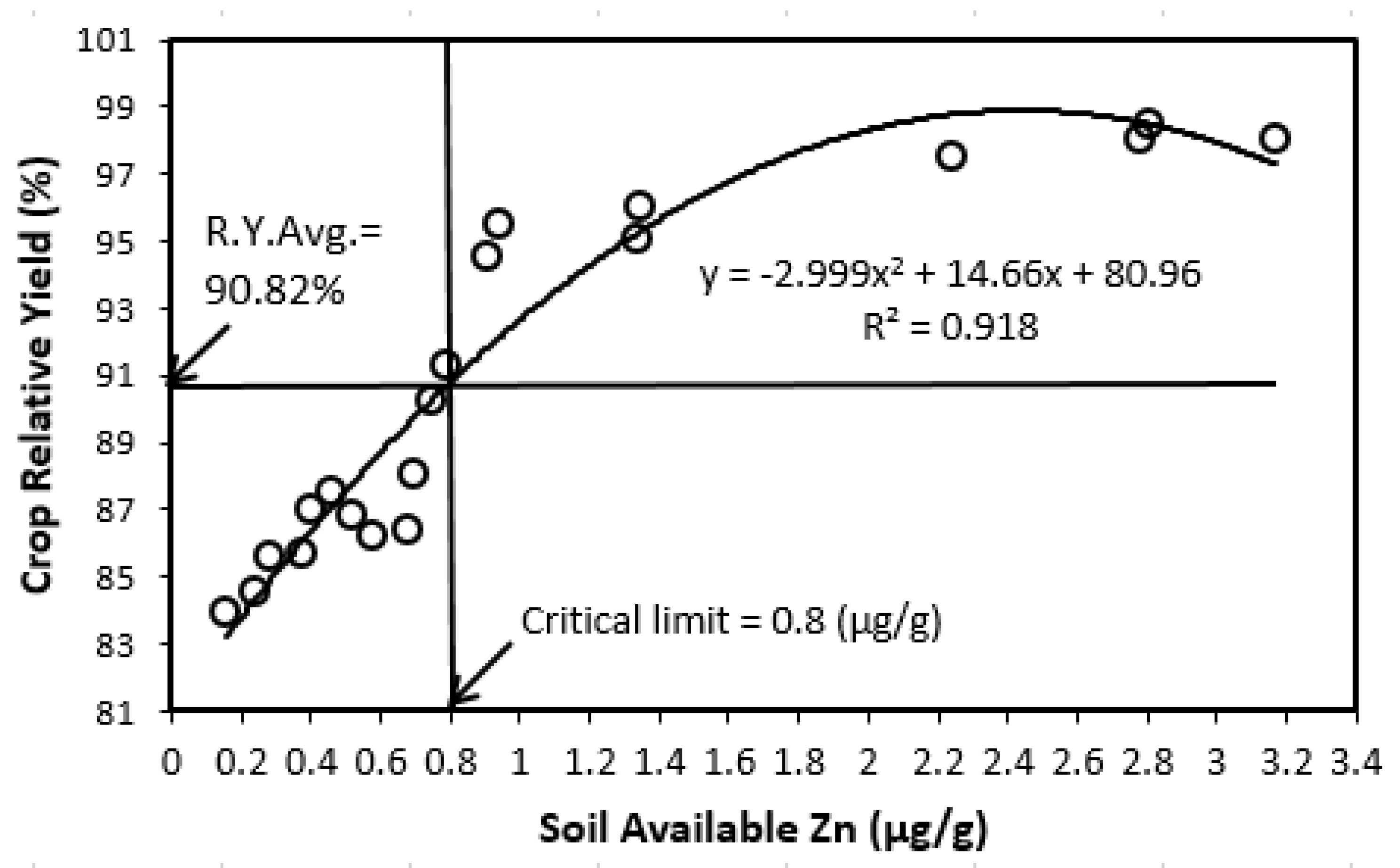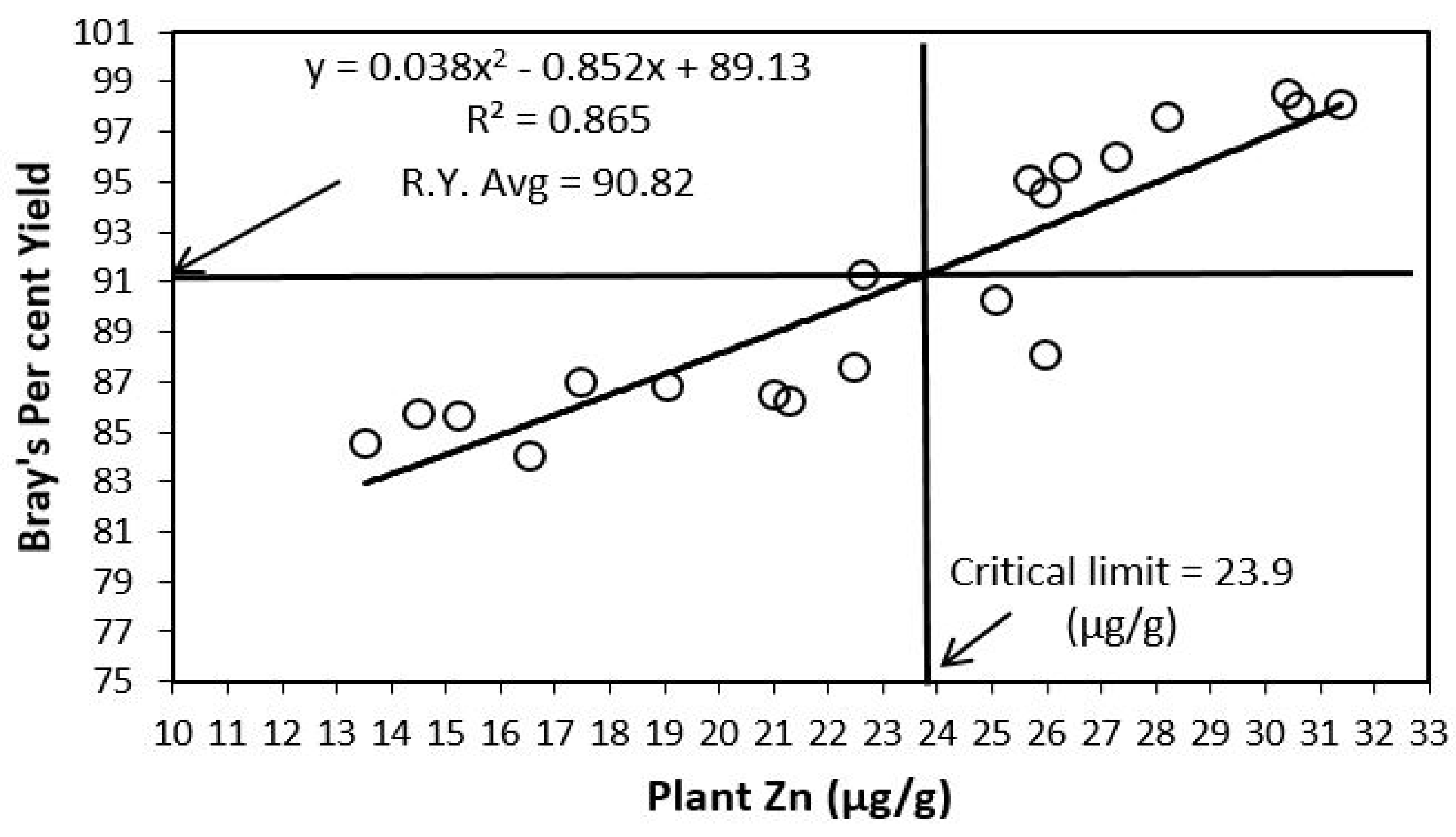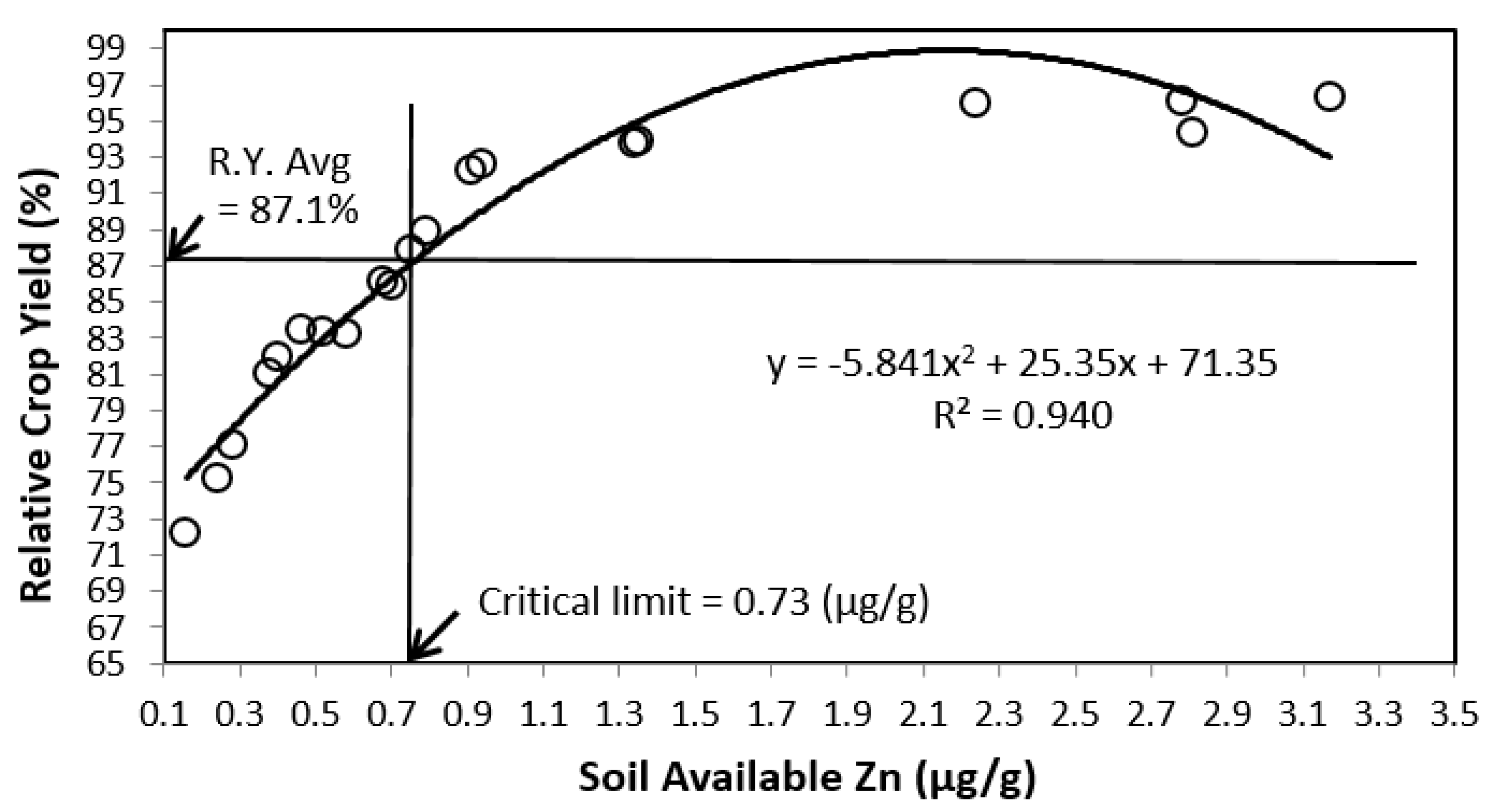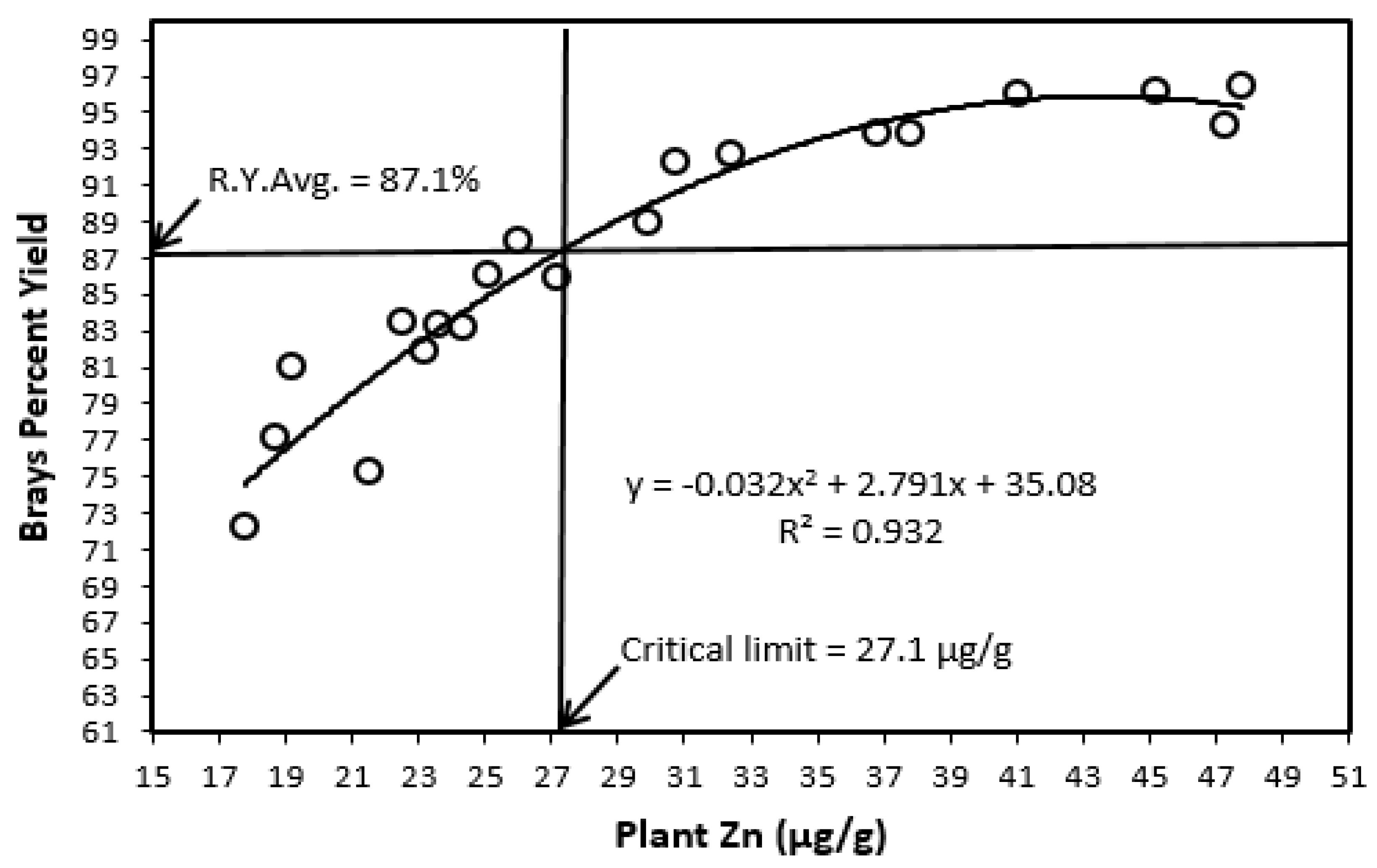Determination of Critical Limit of Zinc for Rice (Oryza sativa L.) and Potato (Solanum tuberosum L.) Cultivation in Floodplain Soils of Bangladesh
Abstract
:1. Introduction
2. Materials and Methods
2.1. Soil Collection, Analysis and Test Crop
2.2. Experimental Design and Approach
2.3. Critical Limit Determination by Graphical and Statistical Approaches
2.4. Statistical Analysis
3. Results
3.1. Dry Matter Accumulation of Rice and Potato
3.2. Critical Limits of Zn in Soil and Plant for Rice
3.3. Critical Limits of Zn in Soil and Plant for Potato
4. Discussion
5. Conclusions
Supplementary Materials
Author Contributions
Funding
Institutional Review Board Statement
Informed Consent Statement
Data Availability Statement
Acknowledgments
Conflicts of Interest
References
- Fageria, N.K.; Baligar, V.C.; Clark, R.B. Micronutrients in crop production. Adv. Agron. 2002, 77, 185–268. [Google Scholar]
- Das, D.K. Micronutrients: Their Behavior in Soils and Plants; Kalyani Publishers: New Delhi, India, 2003. [Google Scholar]
- Singh, K. Determination of critical limit of zinc in rice soils in India for predicting response of rice to zinc application. Field Crops Res. 1984, 9, 143–149. [Google Scholar] [CrossRef]
- Rattan, R.K.; Patel, K.P.; Manjaiah, K.M.; Datta, S.P. Micronutrients in soil, plant animal and human health. J. Indian Soc. Soil. Sci. 2009, 57, 546–558. [Google Scholar]
- IRRI. Annual Report for 1977. P.O. Box-933; IRRI: Manila, Philippines, 1978. [Google Scholar]
- Shah, A.L.; Rahman, M.S.; Aziz, M.A. Outlook for fertilizer consumption and food production in Bangladesh. Bangladesh J. Agric. Environ. 2008, 4, 9–26. [Google Scholar]
- SRDI. Land and Soil Statistical Appraisal Book of Bangladesh; Soil Resource Development Institute, Farmgate: Dhaka, Bangladesh, 2010.
- Prasad, R.; Prasad, L.C.; Agrawal, R.K. Genetic diversity in Indian germplasm of aromatic rice. ORYZA-Int. J. Rice 2010, 46, 197–201. [Google Scholar]
- Parthipan, T.; Ravi, V. Productivity of transplanted rice as influenced by weed control methods. Afr. J. Agric. Res. 2016, 11, 1445–1449. [Google Scholar]
- Flis, B.; Zimnoch-Guzowska, E.; Mankwski, D. Correlations among yield, taste, tuber characteristics and mineral contents of potato cultivars grown at different growing conditions. J. Agric. Sci. 2012, 4, 197–207. [Google Scholar] [CrossRef]
- White, P.J.; Bradshaw, J.E.; Dale, M.F.B.; Ramsay, G. Relationship between yield and mineral concentrations in potato tubers. HortScience 2009, 44, 6–11. [Google Scholar] [CrossRef]
- Blagoeva, V.; Iliev, E.; Nikolova, E. Potatoes-Growing, Diseases and Enemies, Storage; The Publishing House: Westminster, CO, USA, 2004; p. 105. [Google Scholar]
- Ulrich, A. Plant analysis in sugar beet nutrition. In Plant Analysis and Fertilizer Problems; American Institute of Biological Science: Washington, DC, USA, 1959; pp. 190–211. [Google Scholar]
- Smith, P.F. Mineral analysis of plant tissues. Ann. Rev. Plant Physiol. 1962, 13, 81–108. [Google Scholar] [CrossRef]
- Cate, R.B.; Nelson, L.A. Graphical procedure for critical limits of nutrients. Proc. Soil Sci. Soc. Am. 1965, 89, 658. [Google Scholar]
- Cate, R.B.; Nelson, L.A. A simple statistical procedure for partitioning soil test correlation data into classes. Proc. Soil Sci. Soc. Am. 1971, 35, 658–659. [Google Scholar] [CrossRef]
- Page, A.I.; Miller, R.H.; Keeney, D.R. Methods of Soil Analysis. Part 2, 2nd ed.; American Society of Agronomy Inc.: Madison, WI, USA, 1989. [Google Scholar]
- Lindsay, W.L.; Norvell, W.A. Development of a DTPA Soil Test for Zinc, Iron, Manganese, and Copper. Soil Sci. Soc. Am. J. 1978, 42, 421–428. [Google Scholar] [CrossRef]
- Gomez, K.A.; Gomez, A.A. Statistical Procedures for Agricultural Research, 2nd ed.; John Wiley and Sons: New York, NY, USA, 1984; p. 680. [Google Scholar]
- Murthy, I.Y.L.N. Critical nutrient limits in major oil seed crops-A review. Fertil. News 2004, 49, 51–55. [Google Scholar]
- Rahman, M.A.; Jahiruddin, M.; Islam, M.R. Critical limit of zinc for rice in calcareous soils. J. Agric. Rural Dev. 2007, 5, 47. [Google Scholar] [CrossRef] [Green Version]
- Muthukumararaja, T.; Sriramachandrasekharan, M.V. Critical limit of zinc for rice soils of Veeranam command area, Tamil Nadu, India. ARPN J. Agril. Biol. Sci. 2012, 7, 22–33. [Google Scholar]
- Gangwar, M.S.; Chandra, S.K. Estimation of critical limit for zinc in rice soils. Commun. Soil Sci. Plant Anal. 1975, 6, 641–654. [Google Scholar] [CrossRef]
- Kumari, M.; Yadav, K.; Nisha, K. Critical limits of zinc in soil and plants for maize in Diaraland soils of Bihar. Environ. Ecol. 2013, 31, 1107–1110. [Google Scholar]
- Sakal, R.; Singh, A.P.; Singh, B.P.; Sinha, R.B. Assessment of some chemical extractants for available zinc in relation to response of rice to applied zinc in Sub-Himalayan Hill and forest soils. Plant Soil. 1984, 79, 417–428. [Google Scholar] [CrossRef]
- Kuldeep, S. The Critical Zinc Deficiency Levels in Indian Soils and Cereal Crops. UC Davis: Department of Plant Sciences. 2009. Available online: https://escholarship.org/uc/item/4h0788h5 (accessed on 14 November 2021).
- Dudde, K.B.; Maleware, G.U. Soil test and plant analysis for diagnosing zinc deficiency in groundnut and mung. Ann. Plant Physiol. 2005, 19, 75–79. [Google Scholar]
- Yesmin, R.; Hossain, M.; Kibria, M.G.; Jahiruddin, M.; Solaiman, Z.M.; Bokhtiar, S.M.; Hossain, M.B.; Satter, M.A.; Abedin, M.A. Evaluation of Critical Limit of Sulphur in Soils for Wheat (Triticum aestivum L.) and Mustard (Brassica napus L.). Sustainability 2021, 13, 8325. [Google Scholar] [CrossRef]
- Farzana, S.; Sarkar, A.; Hosenuzzaman, M.; Galib, M.A.A.; Hoque, M.A. Effects of zinc on growth and yield of rice cv. BRRI dhan29 under alternate wetting and drying water management practice. J. Food Agric. Environ. 2021, 2, 25–30. [Google Scholar] [CrossRef]
- Naik, S.K.; Das, D.K. Evaluation of various zinc extractants in low land rice soil under the influence of zinc sulphate and chelated zinc. Commun. Soil. Sci. Plant Anal. 2010, 41, 122–134. [Google Scholar] [CrossRef]
- Mahata, M.K.; Debnath, P.; Ghosh, S.K. Critical limits of zinc in soil and rice plant grown in alluvial soils of West Bengal, India. SAARC J. Agric 2012, 10, 137–146. [Google Scholar] [CrossRef] [Green Version]
- Pareek, F.; Ghazanchi, R. Study of the effect of chemical fertilizers, compost and their combination on Aloe vera growth and yield. Sci. Res. 2012, 5, 64–66. [Google Scholar]
- Rashid, A.; Fox, R.L. Evaluating internal zinc requirements of grain crops by seed analysis. Agron. J. 1992, 84, 469–474. [Google Scholar] [CrossRef]




| Soil Sample No. | Textural Class (USDA) | pH | EC (dS/m) | Organic Matter (%) | Zn (µg/g) |
|---|---|---|---|---|---|
| 1 | Loam | 6.83 | 0.14 | 0.82 | 0.16 |
| 2 | Silt Clay Loam | 7.08 | 0.13 | 1.50 | 0.24 |
| 3 | Silt Loam | 6.89 | 0.24 | 1.10 | 0.28 |
| 4 | Silt Loam | 7.46 | 0.12 | 1.74 | 0.38 |
| 5 | Silt Loam | 5.51 | 0.07 | 1.91 | 0.40 |
| 6 | Loam | 5.67 | 0.11 | 1.5 | 0.46 |
| 7 | Sandy Loam | 7.25 | 0.11 | 1.34 | 0.52 |
| 8 | Silt Loam | 6.88 | 0.16 | 1.34 | 0.58 |
| 9 | Loam | 7.48 | 0.12 | 1.00 | 0.68 |
| 10 | Silt Loam | 5.26 | 0.07 | 2.86 | 0.70 |
| 11 | Silt Loam | 6.50 | 0.13 | 1.63 | 0.75 |
| 12 | Silt Clay Loam | 6.12 | 0.08 | 3.91 | 0.82 |
| 13 | Silt Loam | 5.78 | 0.07 | 2.59 | 0.92 |
| 14 | Silt Loam | 6.33 | 0.04 | 1.48 | 0.94 |
| 15 | Silt Loam | 5.25 | 0.06 | 2.86 | 1.34 |
| 16 | Loam | 6.00 | 0.08 | 1.62 | 1.35 |
| 17 | Clay loam | 5.20 | 0.10 | 3.81 | 2.24 |
| 18 | Silt Loam | 5.27 | 0.11 | 2.72 | 2.78 |
| 19 | Silt Loam | 7.34 | 0.16 | 1.60 | 2.81 |
| 20 | Silt Loam | 7.16 | 0.14 | 1.41 | 3.17 |
| Range | - | 5.20–7.48 | 0.04–0.24 | 0.82–3.91 | 0.16–3.17 |
| Mean | - | 6.36 | 0.11 | 1.94 | 1.08 |
| Dry Matter Yield of Rice (g/pot) | Dry Matter Yield of Potato (g/pot) | |
|---|---|---|
| Zn Status | ||
| Low | 14.96 | 4.20 |
| Medium | 20.33 | 5.59 |
| High | 26.53 | 6.09 |
| SE | 0.61 | 0.16 |
| CD @ 5% | 1.21 | 0.31 |
| Treatment (T) | ||
| Zn0 | 20.04 | 5.04 |
| Zn4.87 | 21.17 | 5.55 |
| SE | 0.49 | 0.12 |
| CD @ 5% | 0.96 | 0.25 |
| Interaction (Zn T) | ||
| SE | 0.7513 | 0.19 |
| CD @ 5% | NS | NS |
Publisher’s Note: MDPI stays neutral with regard to jurisdictional claims in published maps and institutional affiliations. |
© 2021 by the authors. Licensee MDPI, Basel, Switzerland. This article is an open access article distributed under the terms and conditions of the Creative Commons Attribution (CC BY) license (https://creativecommons.org/licenses/by/4.0/).
Share and Cite
Rahman, M.; Jahangir, M.M.R.; Kibria, M.G.; Hossain, M.; Hosenuzzaman, M.; Solaiman, Z.M.; Abedin, M.A. Determination of Critical Limit of Zinc for Rice (Oryza sativa L.) and Potato (Solanum tuberosum L.) Cultivation in Floodplain Soils of Bangladesh. Sustainability 2022, 14, 167. https://doi.org/10.3390/su14010167
Rahman M, Jahangir MMR, Kibria MG, Hossain M, Hosenuzzaman M, Solaiman ZM, Abedin MA. Determination of Critical Limit of Zinc for Rice (Oryza sativa L.) and Potato (Solanum tuberosum L.) Cultivation in Floodplain Soils of Bangladesh. Sustainability. 2022; 14(1):167. https://doi.org/10.3390/su14010167
Chicago/Turabian StyleRahman, Mamunur, Mohammad Mofizur Rahman Jahangir, Mohammad Golam Kibria, Mahmud Hossain, Md Hosenuzzaman, Zakaria M. Solaiman, and Md Anwarul Abedin. 2022. "Determination of Critical Limit of Zinc for Rice (Oryza sativa L.) and Potato (Solanum tuberosum L.) Cultivation in Floodplain Soils of Bangladesh" Sustainability 14, no. 1: 167. https://doi.org/10.3390/su14010167
APA StyleRahman, M., Jahangir, M. M. R., Kibria, M. G., Hossain, M., Hosenuzzaman, M., Solaiman, Z. M., & Abedin, M. A. (2022). Determination of Critical Limit of Zinc for Rice (Oryza sativa L.) and Potato (Solanum tuberosum L.) Cultivation in Floodplain Soils of Bangladesh. Sustainability, 14(1), 167. https://doi.org/10.3390/su14010167







